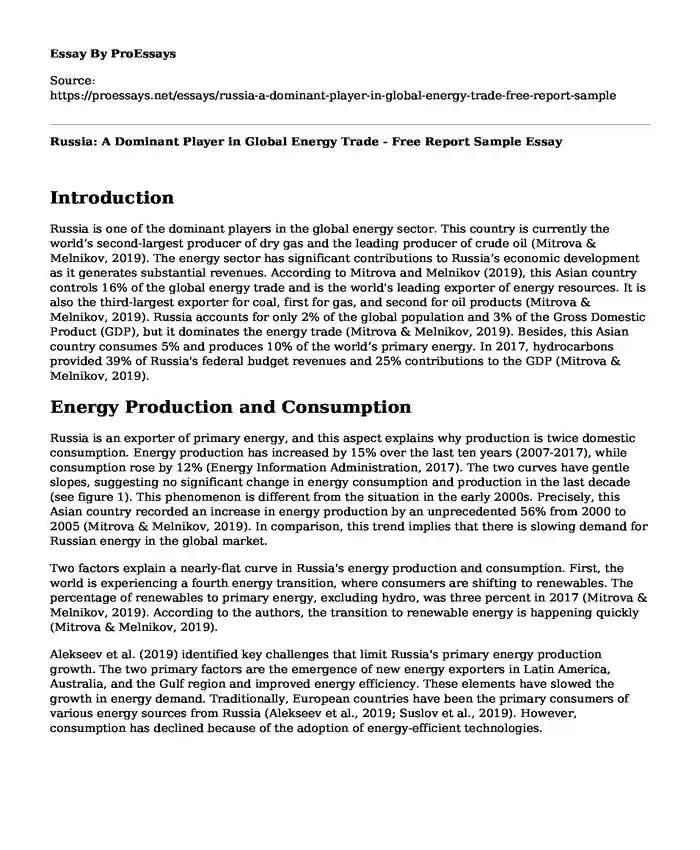Introduction
Russia is one of the dominant players in the global energy sector. This country is currently the world’s second-largest producer of dry gas and the leading producer of crude oil (Mitrova & Melnikov, 2019). The energy sector has significant contributions to Russia’s economic development as it generates substantial revenues. According to Mitrova and Melnikov (2019), this Asian country controls 16% of the global energy trade and is the world's leading exporter of energy resources. It is also the third-largest exporter for coal, first for gas, and second for oil products (Mitrova & Melnikov, 2019). Russia accounts for only 2% of the global population and 3% of the Gross Domestic Product (GDP), but it dominates the energy trade (Mitrova & Melnikov, 2019). Besides, this Asian country consumes 5% and produces 10% of the world’s primary energy. In 2017, hydrocarbons provided 39% of Russia's federal budget revenues and 25% contributions to the GDP (Mitrova & Melnikov, 2019).
Energy Production and Consumption
Russia is an exporter of primary energy, and this aspect explains why production is twice domestic consumption. Energy production has increased by 15% over the last ten years (2007-2017), while consumption rose by 12% (Energy Information Administration, 2017). The two curves have gentle slopes, suggesting no significant change in energy consumption and production in the last decade (see figure 1). This phenomenon is different from the situation in the early 2000s. Precisely, this Asian country recorded an increase in energy production by an unprecedented 56% from 2000 to 2005 (Mitrova & Melnikov, 2019). In comparison, this trend implies that there is slowing demand for Russian energy in the global market.
Two factors explain a nearly-flat curve in Russia's energy production and consumption. First, the world is experiencing a fourth energy transition, where consumers are shifting to renewables. The percentage of renewables to primary energy, excluding hydro, was three percent in 2017 (Mitrova & Melnikov, 2019). According to the authors, the transition to renewable energy is happening quickly (Mitrova & Melnikov, 2019).
Alekseev et al. (2019) identified key challenges that limit Russia's primary energy production growth. The two primary factors are the emergence of new energy exporters in Latin America, Australia, and the Gulf region and improved energy efficiency. These elements have slowed the growth in energy demand. Traditionally, European countries have been the primary consumers of various energy sources from Russia (Alekseev et al., 2019; Suslov et al., 2019). However, consumption has declined because of the adoption of energy-efficient technologies.
Russia’s Energy Portfolio
Fossil fuels remain the major component in Russia's energy balance. Natural gas and petroleum account for the highest proportion of domestic primary energy consumption. Specifically, natural gas accounts for 52% of Russian energy consumption (Energy Information Administration, 2017). Other commodities are petroleum (22%), coal (13%), nuclear renewables, and others at 13%. The portfolio of Russian’s energy consumption is cauterized as follows: industry 41%, transport (22%), residential or buildings (35%), and agriculture (2%) (International Renewable Energy Agency, 2017). The major sources of energy in this country and their proportion to total energy production are natural gas (39%), coal (16%), petroleum (39%), nuclear and other renewables (6%) (Energy Information Administration, 2017).
Conclusion
Thus, international policies to combat climate change has slowed primary energy production as the country aims to achieve its decarburization targets. Here, profound changes in the global energy market have significant impacts on Russia's energy sector since it is the largest exporter of crude oil.
References
Alekseev, A. N., Bogoviz, A. V., Goncharenko, L. P., & Sybachin, S. A. (2019). A critical review of Russia’s energy strategy in the period until 2035. International Journal of Energy Economics and Policy, 9(6), 95-102. https://doi.org/10.32479/ijeep.8263
Energy Information Administration. (2017). The energy sector in Russia. https://www.eia.gov/international/overview/country/RUS
International Renewable Energy Agency. (2017). Renewable energy prospects for the Russian Federation. https://www.irena.org/-/media/Files/IRENA/Agency/Publication/2017/Apr/IRENA_REmap_Russia_paper_2017.pdf
Mitrova, T., & Melnikov, Y. (2019). Energy transition in Russia. Energy Transitions, 3(1-2), 73-80. https://doi.org/10.1007/s41825-019-00016-8
Suslov, N. I., Kryukov, V. A., Markova, V. M., & Churashev, V. N. (2019). The energy sector of Russia and Siberia: Problems and prospects. Journal of Physics: Conference Series, 1261, 012035.
https://doi.org/10.1088/1742-6596/1261/1/012035.
Cite this page
Russia: A Dominant Player in Global Energy Trade - Free Report Sample. (2023, Nov 25). Retrieved from https://proessays.net/essays/russia-a-dominant-player-in-global-energy-trade-free-report-sample
If you are the original author of this essay and no longer wish to have it published on the ProEssays website, please click below to request its removal:
- Investigating the Magnetic Field of a Coil Using a Smartphone
- Texas Economic Crunch Annotated Bibliography Paper Example
- Paper Example on Fertility Rates: Italy vs U.S.
- Essay Example on Childhood Obesity in Alabama: A Community Health Assessment
- Essay Sample on Driverless Cars: The Future of Shared Transportation
- U.S. Gov't Forced Native Americans to Settle in Unfavorable Lands - Essay Sample
- Female Discrimination in Latin America - Report Example







